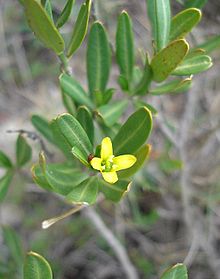
The Rutaceae is a family, commonly known as the rue or citrus family, of flowering plants, usually placed in the order Sapindales.
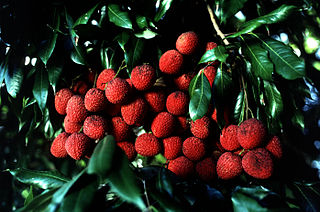
The Sapindaceae are a family of flowering plants in the order Sapindales known as the soapberry family. It contains 138 genera and 1858 accepted species. Examples include horse chestnut, maples, ackee and lychee.

Daphne is a genus of between 70 and 95 species of deciduous and evergreen shrubs in the family Thymelaeaceae, native to Asia, Europe and north Africa. They are noted for their scented flowers and often brightly coloured berries. Two species are used to make paper. Many species are grown in gardens as ornamental plants; the smaller species are often used in rock gardens. All parts of daphnes are poisonous, especially the berries.
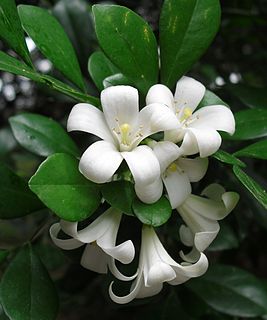
Murraya is a genus of flowering plants in the citrus family, Rutaceae. It is distributed in Asia, Australia, and the Pacific Islands. The center of diversity is in southern China and Southeast Asia.

Chloroxylon is a genus of trees in the family Rutaceae. The genus comprises two species, both desired for their wood as high quality tropical timber and heavily exploited.
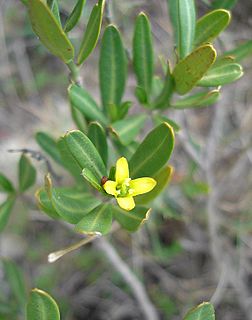
Cneorum tricoccon, the spurge olive, is a small shrub of the family Rutaceae, native to Europe in the western Mediterranean Region.

Geijera is a genus of shrubs and trees in the family Rutaceae and are native to New Guinea, Australia and New Caledonia. They have simple leaves arranged alternately, panicles of bisexual flowers usually with five, sometimes four, sepals, petals and stamens and fruit containing shiny black seeds.
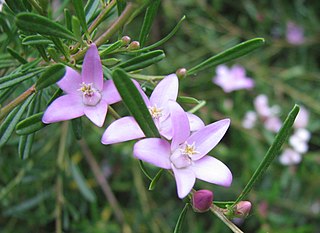
Crowea is a genus of small evergreen shrubs in the family Rutaceae, sometimes known as waxflowers. There are three species and many subspecies and cultivars, all of which are popular as ornamentals because of their abundant, attractive flowers which often occur during autumn and winter. Crowea species are all endemic to Australia, where they occur in Victoria, New South Wales and Western Australia.

The furanocoumarins, or furocoumarins, are a class of organic chemical compounds produced by a variety of plants. Most of the plant species found to contain furanocoumarins belong to a handful of plant families. The families Apiaceae and Rutaceae include the largest numbers of plant species that contain furanocoumarins. The families Moraceae and Fabaceae include a few, widely distributed plant species that contain furanocoumarins.
Oxanthera brevipes is a species of plant in the family Rutaceae. It is endemic to New Caledonia. It was proposed as a novel species by Benjamin C. Stone based on two specimens, distinguished from other false oranges by a non-articulated petiole. The genus Oxanthera has been synonymized with Citrus, but a name in Citrus does not appear to have been published, and Plants of the World Online regards "Oxanthera brevipes" as an unplaced name.
Citrus neocaledonica, synonym Oxanthera neocaledonica, the large leaf oxanthera, is a species of plant in the family Rutaceae. It is endemic to New Caledonia.
Spathelia is a genus in the plant family Rutaceae, subfamily Cneoroideae.. Species records are from central America and the Caribbean.
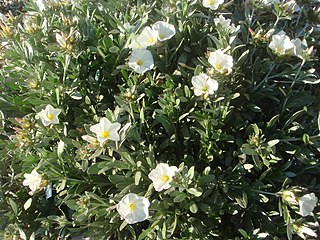
Convolvulus cneorum, the silverbush or shrubby bindweed, is a species of flowering plant in the family Convolvulaceae, which contains many plants described as "bindweed". The Latin specific epithet cneorum is a word of Greek origin referring to a small olive-like plant, possibly a species of Daphne.
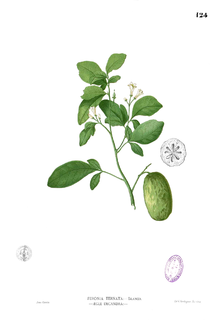
Aurantioideae is the subfamily within the rue and citrus family (Rutaceae) that contains the citrus. The subfamily's center of diversity is in the monsoon region of eastern Australasia, extending west through South Asia into Africa, and eastwards into Polynesia.

Cneoroideae is a subfamily of flowering plants that belongs to the family Rutaceae. The subfamilies Dictyolomatoideae and Spathelioideae are now included in the subfamily Cneoroideae.

Ballota pseudodictamnus, the false dittany, is a species of flowering plant in the mint family Lamiaceae, native to the southern Aegean region.
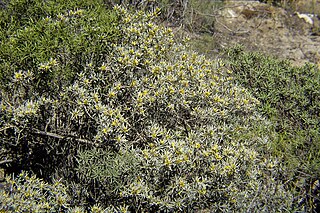
Cneorum pulverulentum is a species of flowering plant in the family Rutaceae, native to the Canary Islands. It was first described by Étienne Ventenat.
Marco Duretto is a manager and senior research scientist at the Royal Botanic Gardens Sydney in Australia.
Zanthoxyloideae is a subfamily of the family Rutaceae.
